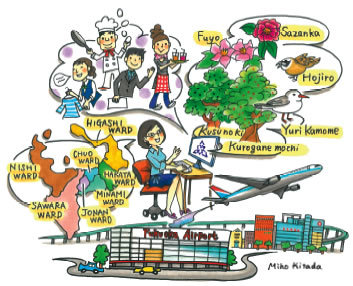Hakata Culture vol.6
Fukuoka City by Numbers

Did you know that a new municipal directory is published every year to coincide with the start of the business year on April 1? It presents an overview of the most up-to-date statistical data on Fukuoka City. It’s also placed on the Fukuoka city website. This month, I’ll profile the city using these new figures. The city’s population keeps growing every year, and as of October 1, 2008, it stood at 1,437,718 people in 684,717 households. The females outnumber the males; there were 749,668 women to 688,050 men. Fukuoka is a relatively young city for Japan, with an average age of 40.3. The city has seven wards, the most populous of which is Higashi Ward. In contrast, Jonan Ward has the fewest people. Characteristic of Fukuoka’s industrial structure is the concentration of tertiary industry, which includes the retail sector, the service industry, and eating and drinking places. This is Fukuoka City’s basic industry. Of the 769,900 employed workers in the city, Primary industry―agriculture and fisheries―accounts for only 0.1%, or 446 people. Secondary industry (manufacturing) employs 89,287 people, or 11.6% of the workforce. The remaining 680,167 people work in Tertiary industry.
Many financial institutions make Fukuoka City their home, and the city also has Kyushu’s only stock exchange. Symbolic of the city’s convenience is the nearness of Fukuoka Airport. It is only five minutes by subway from Hakata Station, and just 11 minutes away from Tenjin, the city’s primary shopping district, which is also an important business district. The airport is easily accessible by expressway, so many people throughout Kyushu use it. The airport has flights to 22 cities in Japan and 16 cities abroad, primarily Asia. It is ranked fourth nationwide in the number of users, as 17.29 million passengers pass through the terminal a year. The city’s symbol was selected in a nationwide contest in 1909, and features an arrangement of nine katakana characters that represent “fu”. Its official trees and flowers were determined in 1979 on the 90th anniversary of its incorporation as a municipality. The “town tree” is the Round Leaf Holly, the “plaza tree” is the Camphor Laurel, the Summer flower is the Cotton Rosemallow, and the Winter flower is the Sazanqua. In 1989, on the occasion of the city’s 100th anniversary, the meadow bunting and the black-headed gull were selected as its official birds. This year marks the 120th anniversary of Fukuoka City’s incorporation as a municipality. Why not look at the municipal directory to find out more about the city?
www.city.fukuoka.lg.jp/shisei/profile/
A public relations manager
Kimiyo Sasaki
福岡市の基礎知識
毎年新年度が始まる4月1日に、市政要覧という報告書を作成しているのをご存じですか?もっとも新しい数字やデータで福岡市の概要を紹介、福岡市のホームページに掲載しています。今回は新しい数字とともに福岡市を案内します。
まず人口、福岡市の人口は年々増加していて現在(平成20年10月1日)は1,437,718人、世帯数は684,717世帯。そのうち、男性は 688,050人、女性は749,668人と、女性の数が多く、平均年齢は40.3歳で比較的若い街でもあります。福岡市には7つの区があり、最も人口が多いのは東区、少ないのは城南区です。
福岡市の産業構造は第3次産業と呼ばれる小売業やサービス業、飲食店に集中しているのが特徴。福岡市の基幹産業となっています。従業者数も全体で769,900人のうち、第1次産業(農業・漁業など)は446人と全体の0.1%、第2次産業(工業など)は 89,287人で11.6%、残り680,167人が第3次産業で働いています。また、福岡市には金融機関も多く、九州で唯一の証券取引所もあります。
そして福岡市の便利さを象徴しているのが福岡空港の近さ。地下鉄で博多駅から5分、ショッピングゾーンでありオフィス街でもある天神からでも11分でアクセスできるし、高速道路のインターチェンジからも近いので九州一円から利用者があつまります。国内線は22都市と、国際線はアジアを中心に16都市と結ばれており、年間約1,729万人で、全国第4位の利用者数となっています。
福岡市のマークは明治42年(1909)に全国懸賞募集で決まりました。カタカナの「フ」を9個組み合わせたものです。市の木と花は市制90周年の昭和54年(1979)に制定、町の木に「クロガネモチ」、広場の木に「クスノキ」が、夏の花には「フヨウ」、冬の花に「サザンカ」が決定。市の鳥は平成元年(1989)の100周年にホオジロとユリカモメが選ばれています。
今年は市制120周年、福岡市の姿、ちょっと見えてきましたか?
www.city.fukuoka.lg.jp/shisei/profile/
福岡市広報課長 佐々木 喜美代

